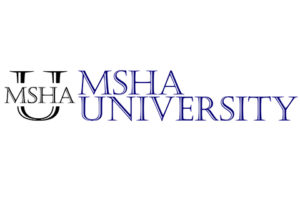The Mine Safety and Health Administration (MSHA) was created by the 1977 Mine Act to establish, support, and enforce U.S. mining regulations. As part of its mission to “prevent death, illness, and injury from mining and promote safe and healthful workplaces for U.S. miners,” MSHA oversees Title 30 of the Code of Federal Regulations (CFR) that defines rules for training and retraining of miners and independent mining contractors. There are over 90 “parts” within Title 30 CFR that define regulations related to U.S. mineral resources.
So, what is MSHA Part 46? MSHA Part 46 is the federal regulation that defines the “mandatory requirements for training and retraining miners and other persons at shell dredging, sand, gravel, surface stone, surface clay, colloidal phosphate, and surface limestone mines.”
If you’re a new miner or an independent mining contractor about to begin work at a mine, you’ll find the information in this article extremely valuable. You’ll not only learn the difference between Part 46 for surface mining and Part 48 for underground mining, but you’ll also gain a detailed understanding of the training and documentation requirements for U.S. surface, non-metal, non-coal mining.
For detailed instructions on how to comply with Part 46 training requirements, check out our article, “Part 46 Training Requirements – Everything You Need To Know.” You’ll definitely want to check out these two articles on developing compliant documentation too:
- “How To Fill Out An MSHA 5000-23 Certificate Of Training”
- “MSHA Part 46 Training Plan – Essential Development Guide”
Part 46 Outline
Part 46 falls under Subchapter H – Education and Training in Title 30 of the Code of Federal Regulations (30 CFR). Containing 12 sections, Part 46 defines the requirements for “training and retraining miners and other persons at shell dredging, sand, gravel, surface stone, surface clay, colloidal phosphate, and surface limestone mines.”
The 12 sections that comprise Part 46 include:
- 46.1 – Scope
- 46.2 – Definitions
- 46.3 – Training plans
- 46.4 – Training plan implementation
- 46.5 – New miner training
- 46.6 – Newly hired experienced miner training
- 46.7 – New task training
- 46.8 – Annual refresher training
- 46.9 – Records of training
- 46.10 – Compensation for training
- 46.11 – Site-specific hazard awareness training
- 46.12 – Responsibility for independent contractor training
Section 46.1 – Scope
“The provisions of this part set forth the mandatory requirements for training and retraining miners and other persons at shell dredging, sand, gravel, surface stone, surface clay, colloidal phosphate, and surface limestone mines.”
Part 46 is the fundamental set of regulations that define training requirements for miners and mining contractors at surface stone, sand, and gravel mines. The primary criteria for establishing what type of mine falls under Part 46 regulations are that the mine must:
- Have surface operations only
- Extract only non-metal, non-coal, non-gemstone commodities
If you currently work or will perform work at a mine that fits any one of the following criteria, you’ll be required to comply with Part 48 regulations (which are stricter and require more training hours):
- Underground mining operation
- Surface areas of an underground mine
- Coal mining (surface or underground)
- Metal mining (surface or underground)
- Gemstone mining (surface or underground)
Section 46.2 – Definitions
This section outlines key definitions that apply to Part 46. We’ll review some of the most common definitions here and reference others within the sections of Part 46 where they are directly relevant.
- The Act or The Mine Act – (a) Act means the Federal Mine Safety and Health Act of 1977.
- Competent Person – (b) Competent person means a person designated by the production-operator or independent contractor who has the ability, training, knowledge, or experience to provide training to miners in his or her area of expertise. The competent person must be able both to effectively communicate the training subject to miners and to evaluate whether the training given to miners is effective.
- Independent Contractor or Mining Contractor – (e) Independent contractor means any person, partnership, corporation, subsidiary of a corporation, firm, association, or other organization that contracts to perform services at a mine under this part.
- The Mine or Mine Site – (f) Mine site means an area of the mine where mining operations occur.
- Miner – (g)(1) Miner means: (i) Any person, including any operator or supervisor, who works at a mine and who is engaged in mining operations. This definition includes independent contractors and employees of independent contractors who are engaged in mining operations; and (ii) Any construction worker who is exposed to hazards of mining operations. (2) The definition of “miner” does not include scientific workers; delivery workers; customers (including commercial over-the-road truck drivers); vendors; or visitors. This definition also does not include maintenance or service workers who do not work at a mine site for frequent or extended periods.
- Mining Operations – (h) Mining operations means mine development, drilling, blasting, extraction, milling, crushing, screening, or sizing of minerals at a mine; maintenance and repair of mining equipment; and associated haulage of materials within the mine from these activities.
- Operator – (l) Operator means any production-operator, or any independent contractor whose employees perform services at a mine.
- Mine Operator or Production Operator – (m) Production-operator means any owner, lessee, or other person who operates, controls, or supervises a mine under this part.
- We – (o) We or us means the Mine Safety and Health Administration (MSHA).
- You – (p) You means production-operators and independent contractors.
TIP! – For all definitions listed within this section, please go to our RESOURCES page for a link to 30 CFR – Part 46.
Section 46.3 – Training Plans
This section outlines the requirements for your written training plan document. You must have a written training plan that provides specific information on the 5 training programs defined by Part 46.
Many people end up confused about MSHA’s use of the terms “training plan” and “training program.” Here’s some clarification.
A training plan is the written document that contains each of the 5 training programs for training miners, mining contractors, and mine visitors based on the requirements outlined in Parts 46.5-46.8 and Part 46.11.
A training program is the specific set of required subjects, amounts of training time, and completion deadlines associated with specific roles or training types. The 5 training programs for Part 46 are:
- New Miner
- Newly Hired Experienced Miner
- New Task
- Annual Refresher
- Site-Specific Hazards
Sections 46.5 through 46.8 and 46.11 define the training requirements for each of the above training programs.
When developing your training plan, MSHA is very flexible with Part 46 mine operators, stating that “A training plan is considered approved by us if it contains, at a minimum, the following information:”
- Mine or Contractor Details – “The name of the production-operator or independent contractor, mine name(s), and MSHA mine identification number(s) or independent contractor identification number(s);
- Responsible Person – The name and
position of the person designated by you [the mine operator or mining
contractor] who is responsible for the health and safety training at the mine.
- IMPORTANT – This is the person who will sign your record of training to certify that training has been completed.
- Teaching Methods, Subjects, and Times – A general description of the teaching methods and the course materials that are to be used in the training program, including the subject areas to be covered and the approximate time or range of time to be spent on each subject area.
- Competent Person(s) – A list of the
persons… who will provide the training, and the subject areas in which each
person and/or organization is competent to instruct; and
- IMPORTANT – This is the person or persons who will conduct training on subjects for which they are deemed competent to teach.
- Evaluation Procedures – The evaluation procedures used to determine the effectiveness of training.”
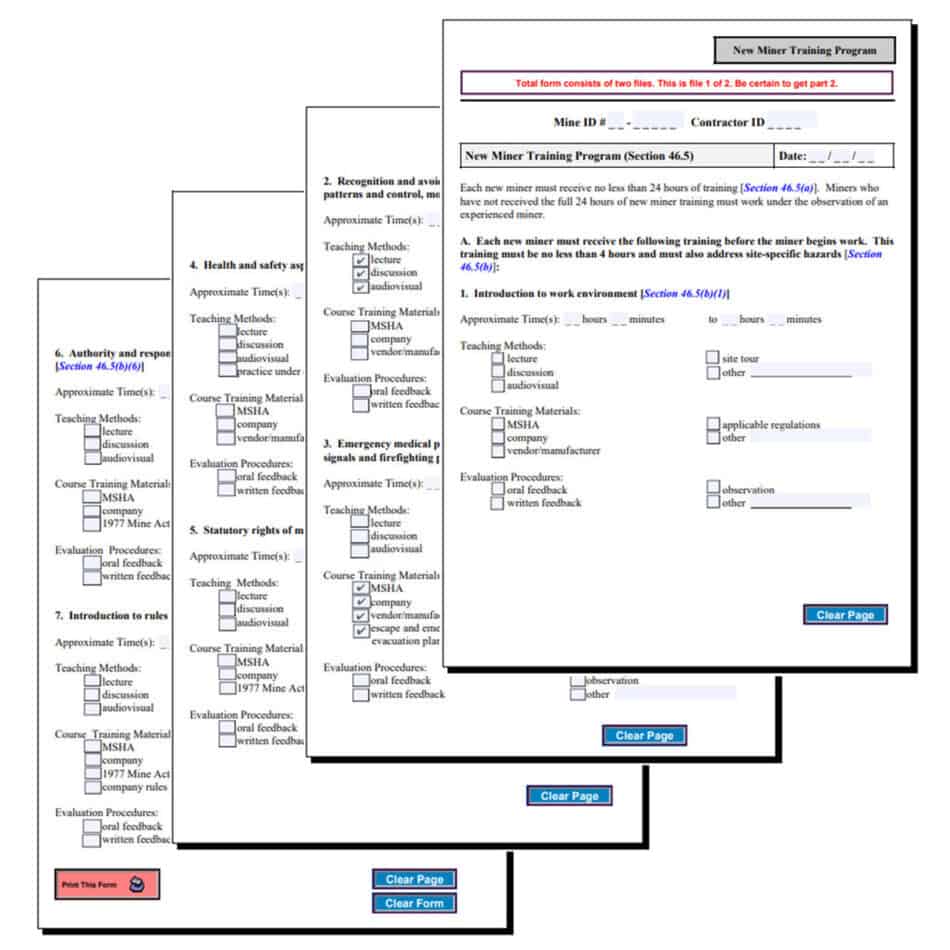
TIP! – Part 46 does not require that MSHA review and officially approve your training plan. As long as your training plan includes each training program with the 5 pieces of information per training program described above, your training plan is “considered approved” by MSHA.
TIP! – It’s wise to have a printed copy of your entire training plan available to provide an MSHA inspector for review upon request.
TIP! – In addition to MSHA inspectors, miners and miners’ representatives have the right to review a copy of your training plan. You must post the training plan at the mine for review at least 2 weeks prior to implementing the plan. Refer to Part 46.3 for additional details and timing of plan reviews and submittals.
Section 46.4 – Training Plan Implementation
MSHA’s requires that any form of training provided to miners is:
- “Conducted in accordance with the written training plan,
- Presented by a competent person, and
- Presented in a language understood by the miners who are receiving the training.”
While MSHA designed Part 46 for mine operators to conduct their
own training of miners, there is no requirement that instructors must be
employees of the mine. MSHA allows mine operators to use outside resources for
training instruction.
However, it’s important to understand that whomever provides training for
required Part 46 subjects must be listed by name in the training plan as the
competent person for that subject.
Competent Person – “46.2(b) Competent person means a person designated by the production-operator or independent contractor who has the ability, training, knowledge, or experience to provide training to miners in his or her area of expertise. The competent person must be able both to effectively communicate the training subject to miners and to evaluate whether the training given to miners is effective.”
MSHA also allows for credit to be applied to Part 46 requirements from training provided by other state or federal agencies (OSHA, for example) as long as the training is relevant to Part 46 training subjects.
Acceptable training methods include:
- Lecture
- Discussion
- Audio-visual media
- Tour of a facility or site
- Practice under close observation of a competent person
- Computer-based or online training
Section 46.5 – New Miner Training
This section covers the training requirements for new miners.
New Miner – “46.2 (i) New miner means a person who is beginning employment as a miner with a production-operator or independent contractor and who is not an experienced miner.”
Independent Contractor or Mining Contractor – “64.2 (e) Independent contractor means any person, partnership, corporation, subsidiary of a corporation, firm, association, or other organization that contracts to perform services at a mine under this part.”
It’s important to understand that MSHA requires exactly the same training and documentation under Part 46 for both miners and mining contractors. Since Part 46 training can be a significant, and often unexpected, expense for mining contractors, additional clarification is needed. So, a mining contractor is further defined as:
- “any person, partnership, corporation, subsidiary of a corporation, firm, association or other organization that contracts to perform services or construction at a mine… [and are] exposed to mine hazards for frequent or extended periods.
- “Frequent” exposure is defined as a pattern of exposure to hazards at mining operations occurring intermittently and repeatedly over time.
- “Extended” exposure means exposure to hazards at mining operations of more than five (5) consecutive work days.”
So, both miners and mining contractors must be provided with a minimum of 24 hours of training with 90 days from beginning work at the mine, with a minimum of 4 hours in specified subjects provided before beginning work at the mine.
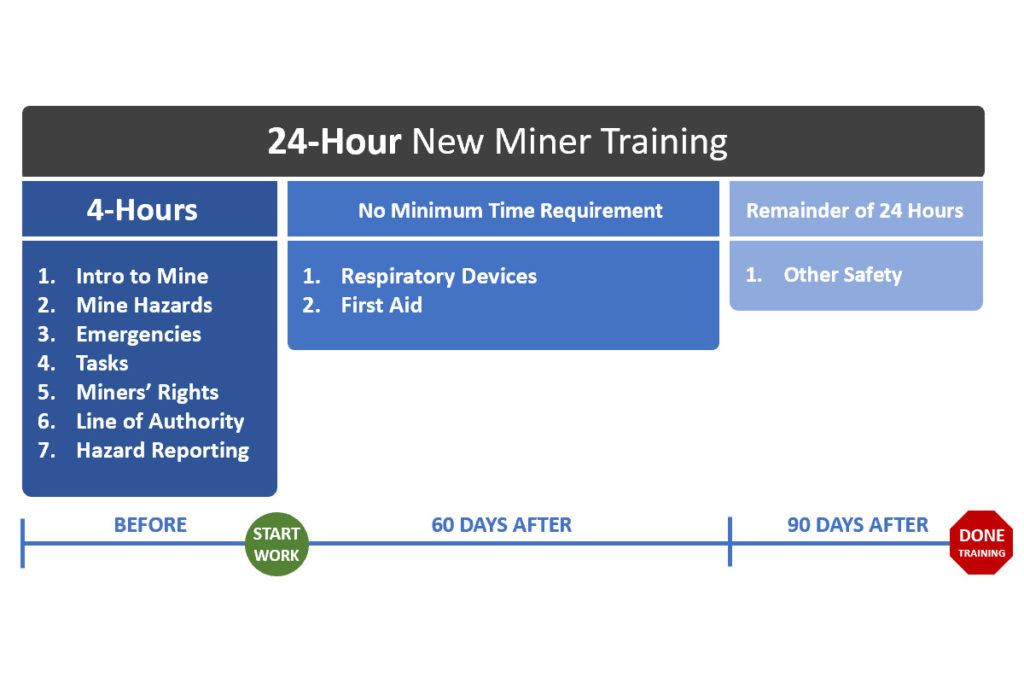
Required Training Subjects BEFORE Beginning Work (4 Hours)
The following 7 subjects must be provided by a competent person at a minimum of 4 hours of training prior to beginning work at the mine:
- Introduction to the Mine – “(1) An introduction to the work environment, including a visit and tour of the mine, or portions of the mine that are representative of the entire mine (walkaround training). The method of mining or operation utilized must be explained and observed;
- Recognition and Avoidance of Hazards – (2) Instruction on the recognition and avoidance of electrical hazards and other hazards present at the mine, such as traffic patterns and control, mobile equipment (e.g., haul trucks and front-end loaders), and loose or unstable ground conditions;
- Emergency Procedures – (3) A review of the emergency medical procedures, escape and emergency evacuation plans, in effect at the mine, and instruction on the firewarning signals and firefighting procedures;
- Health and Safety Aspects of Tasks – (4) Instruction on the health and safety aspects of the tasks to be assigned, including the safe work procedures of such tasks, the mandatory health and safety standards pertinent to such tasks, information about the physical and health hazards of chemicals in the miner’s work area, the protective measures a miner can take against these hazards, and the contents of the mine’s HazCom program;
- Statutory Rights of Miners – (5) Instruction on the statutory rights of miners and their representatives under the Act;
- Line of Authority – (6) A review and description of the line of authority of supervisors and miners’ representatives and the responsibilities of such supervisors and miners’ representatives; and
- Hazard Reporting – (7) An introduction to your rules and procedures for reporting hazards.”
Required Training Subjects WITHIN 60 DAYS Of Beginning Work
The following 2 subjects must be provided by a competent person with no specified minimum of training hours of training within 60 days of beginning work at the mine:
- Respirators – “(1) Instruction and demonstration on the use, care, and maintenance of self-rescue and respiratory devices, if used at the mine; and
- First Aid – (2) A review of first aid methods.”
Required Training WITHIN 90 DAYS Of Beginning Work
While there are no further specific subjects required, any remainder of the minimum 24 hours of training must be completed within 90 days of beginning work at the mine.
TIP! – It’s very common for mine operators and contractor companies to provide 3 consecutive 8-hour days of training to meet the minimum 24-hour training requirement. In this way, all training is completed and documented in a condensed timeframe prior to miners and mining contractors beginning work at the mine. This method eliminates the need to track the 60-day and 90-day deadlines.
Section 46.6 – Newly Hired Experienced Miner Training
This section covers the training requirements for newly hired experienced miners.
Newly Hired Experienced Miner – “46.2 (j) Newly hired experienced miner means an experienced miner who is beginning employment with a production-operator or independent contractor. Experienced miners who move from one mine to another, such as drillers and blasters, but who remain employed by the same production-operator or independent contractor are not considered newly hired experienced miners.”
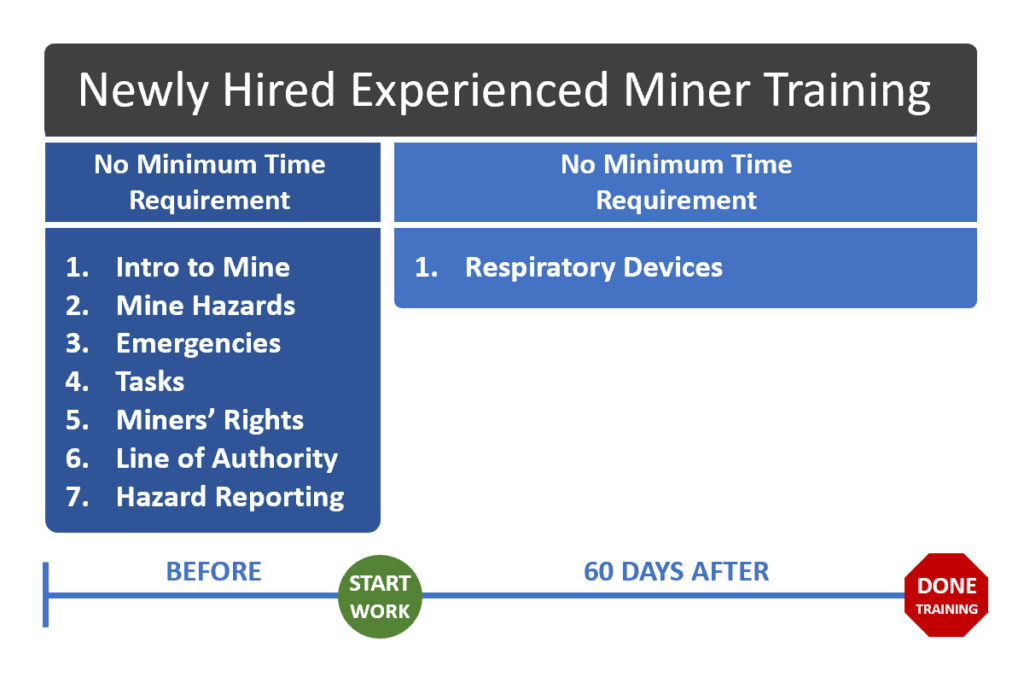
Required Training Subjects BEFORE Beginning Work (No Minimum Time Required)
A newly hired experienced miner is required to received training on the same 7 subjects as a new miner. The training must be provided by a competent person with no minimum hours of training prior to beginning work at the mine
Required Training WITHIN 60 DAYS Of Beginning Work
While there are no minimum training time requirements, a newly hired experience miner must be provided with respirator training within 60 days of beginning work at the mine.
TIP! – It’s very common for mine operators and mining contractor companies to train newly hired experienced miners in the same way as a new miner, with 3 consecutive 8-hour days of training. This method can simplify the training process and ensure that all new employees have consistent training.
Section 46.7 – New Task Training
This section covers the training requirements for new tasks.
New Task – “64.2 (n) Task means a work assignment or component of a job that requires specific job knowledge or experience.”
MSHA provides some additional clarification on what constitutes a new task.
“(a) You must provide any miner who is reassigned to a new task in which he or she has no previous work experience with training in –
- the health and safety aspects of the task to be assigned, including
- the safe work procedures of such task,
- information about the physical and health hazards of chemicals in the miner’s work area,
- the protective measures a miner can take against these hazards, and
- the contents of the mine’s HazCom program.
This training must be provided before the miner performs the new task.”
New task training is NOT required for miners or mining contractors who –
- have received training for a similar task,
- have prior work experience in a similar task,
- can demonstrate their skills in safely performing the task.
TIP! – Time spent on new task training can be credited toward new miner training.
Section 46.8 – Annual Refresher Training
This section covers annual refresher training, requiring a minimum of 8 hours of training provided within 12 months of either beginning work at the mine or since the miner’s or mining contractor’s last annual refresher training.
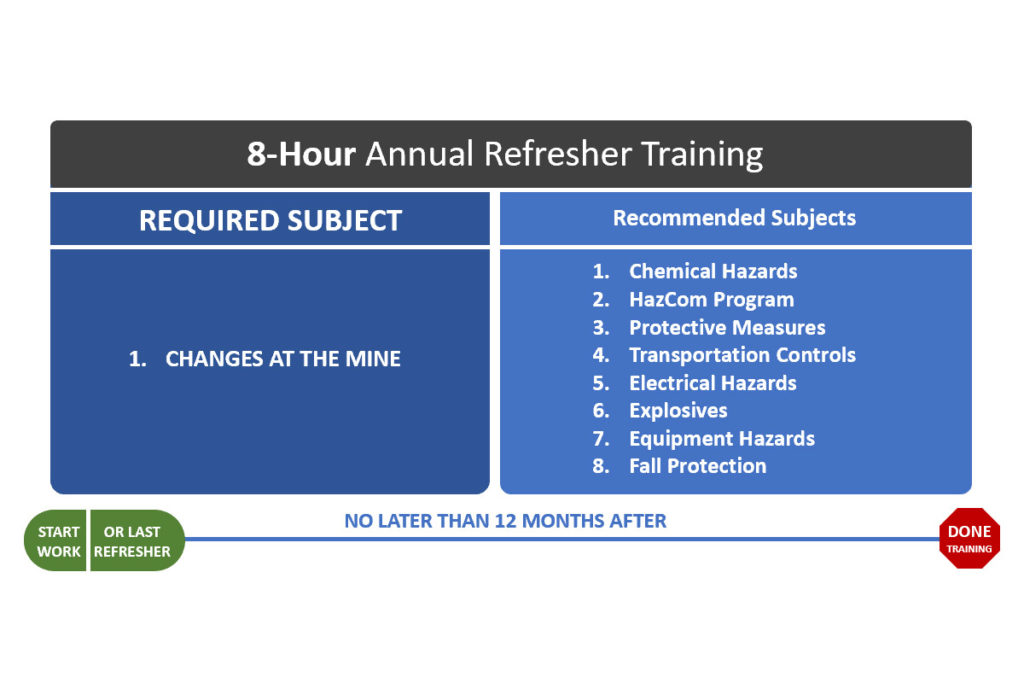
While this section lists numerous “recommended” other training subjects, the ONLY required subject for annual refresher training is –
Changes at the Mine – “(b) The refresher training must include instruction on changes at the mine that could adversely affect the miner’s health or safety.”
MSHA requires that any other training used to meet annual refresher requirements include “other health and safety subjects that are relevant to mining operations at the mine.”
Section 46.9 – Records Of Training
For Part 46, MSHA requires two main types of documentation –
- The Training Plan
- The Record or Certificate of Training
Since we covered the training plan in section 46.3, this section outlines the requirements for “recording and certifying” that compliant training has been completed.
For Part 46, MSHA allows mine operators and contractor companies the choice between using the standard 5000-23 Certificate of Training or a compliant record of training that can be created separately.
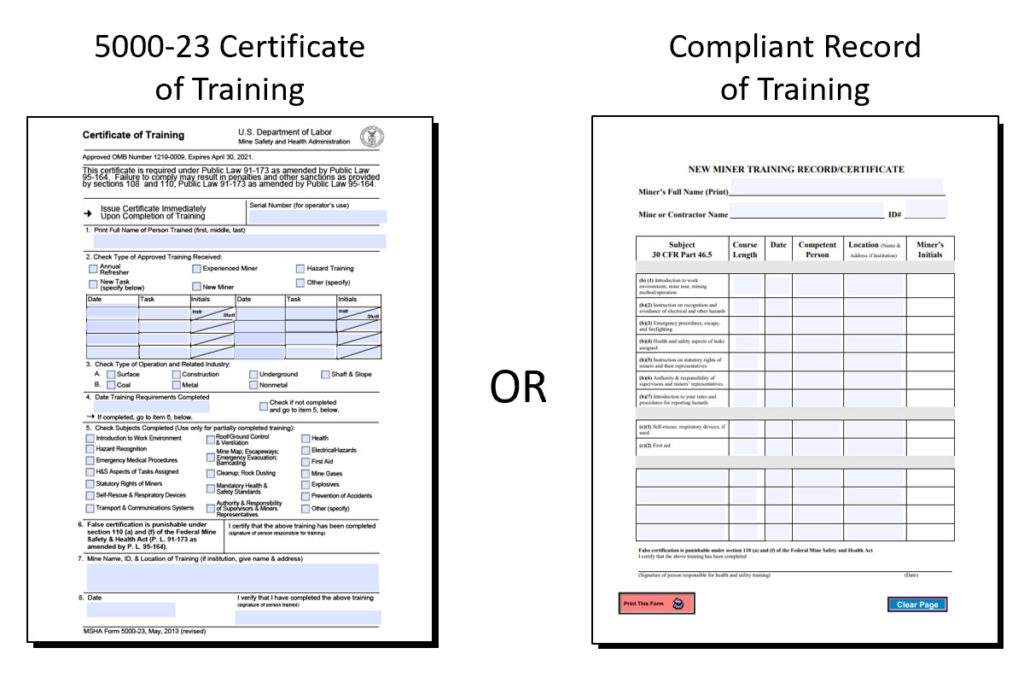
A compliant record of training you create on your own must include these 5 sets of information:
- “(1) The name of the production-operator or independent contractor, mine name(s), and MSHA mine identification number(s) or independent contractor identification number(s);
- (2) The name and position of the person designated by you who is responsible for the health and safety training at the mine. This person may be the production-operator or independent contractor;
- (3) A general description of the teaching methods and the course materials that are to be used in the training program, including the subject areas to be covered and the approximate time or range of time to be spent on each subject area.
- (4) A list of the persons and/or organizations who will provide the training, and the subject areas in which each person and/or organization is competent to instruct; and
- (5) The evaluation procedures used to determine the effectiveness of training.”
A certificate or compliant record of training must be made to record and certify training completion:
- For each new miner – When the miner begins work, at 60 days, and finally at 90 days after beginning work.
- For each newly hired experienced miner – When the miner begins work and at 60 days after beginning work.
- Upon completion of new task training
- For each session of annual refresher training
- Upon completion of site-specific hazard training
Records of training must also be:
- Maintained for all current employees (except annual refresher records that must be kept for only two years)
- Provided upon request to each miner who leaves employment at the mine
- Maintained for at least 60 days after a miner leaves employment at the mine
- Made available upon request to MSHA inspectors
TIP! – If you decide to use the 5000-23, check out our article on “How To Fill Out An MSHA 5000-23 Certificate Of Training” for helpful guidance on doing it right.
Section 46.10 – Compensation For Training
MSHA designed Part 46 training to be provided by a mine employer to employee miners during work hours. It’s a common misconception that MSHA training must be attained prior to seeking employment at a mine. Because of the way the training was intended to be provided, all trainees must be paid for training time.
“(a) Training must be conducted during normal working hours. Persons required to receive training must be paid at a rate of pay that corresponds to the rate of pay they would have received had they been performing their normal work tasks.
(b) If training is given at a location other than the normal place of work, persons required to receive such training must be compensated for the additional costs, including mileage, meals, and lodging, they may incur in attending such training sessions.”
Section 46.11 – Site-Specific Hazard Awareness Training
This section covers the training requirements for site-specific hazard awareness training. While there is no minimum amount of time required, this training must be provided before being exposed to mine hazards.
In addition to miners, site-specific hazard training must be provided to anyone who is NOT a miner, but who may be exposed to mine hazards. Those people include:
- “46.11 (b) (1) Office or staff personnel;
- (2) Scientific workers;
- (3) Delivery workers;
- (4) Customers, including commercial over-the-road truck drivers;
- (5) Construction workers or employees of independent contractors who are not miners under §46.2 of this part;
- (6) Maintenance or service workers who do not work at the mine site for frequent or extended periods; and
- (7) Vendors or visitors.”
The training must cover any site-specific health and safety risk the person may be exposed to, including:
- “(d) …unique geologic or environmental conditions,
- recognition and avoidance of hazards such as:
- electrical and powered-haulage hazards,
- traffic patterns and control, and restricted areas; and
- warning and evacuation signals,
- evacuation and emergency procedures, or
- other special safety procedures.”
MSHA allows this type of training to be provided using flexible teaching methods, including:
- Written hazard warnings
- Oral instruction
- Signs and posted warnings
- Walkaround tour training
- Other methods that appropriately alert a person to the site’s hazards
While this type of training is NOT required for individuals who are accompanied at all times by an experienced miner, it is commonly provided to everyone who will enter active mining areas.
Section 46.12 – Responsibility For Independent Contractor Training
This section defines the responsibilities for mining contractors related to training. Effectively, MSHA makes no distinction between the training requirements for miners compared to those for mining contractors.
(See Section 46.5 New Miner Training for MSHA’s detailed definition of a mining contractor)
Each production operator has the responsibility to:
- Provide site-specific hazard training to all mining contractors
- Provide site-specific hazard information to all contractor companies
Each independent mining contractor has the responsibility to:
- Comply with all MSHA regulations, including Part 46 training requirements
- Inform the mine operator of any hazards which could be created by the contractor’s work
Need Help Getting and Staying Compliant?
Just get in touch with us. We’ll be happy to walk you through all of this in more detail. We’re here to help!
Related Questions
What is MSHA Part 48?
MSHA’s Part 48 A & B regulations outline the requirements for training and retraining miners and mining contractors at (A) underground and (B) surface areas of underground metal, coal, and gemstone mines in the U.S.
Check out our article, “3 Major Differences Between MSHA Part 46 and Part 48” for details on what Part 48 is and how it’s different from Part 46.
How is MSHA different from OSHA?
MSHA and OSHA are separate departments within the U.S. Department of Labor. Here’s a brief description of their individual functions:
- MSHA (the Mine Safety and Health Administration) enforces training regulations but requires that training be managed by the mine operator, not the individual miner. While MSHA provides instructor training and approval, the individual miners and mining contractors who receive the training don’t retain their “certifications” personally. They can retain copies of their training certificates, but it’s the mine operator or mining contractor who must maintain compliant training records.
- OSHA (the Occupational Safety and Health Administration) provides and certifies outreach safety training directly to individuals in the form of OSHA 10 and 30-hour programs. The individual carries a certification card with them. However, it is state governments and employers, not OSHA, who require that individuals acquire this certification.
For more on the differences between these two governmental agencies, check out our article, “27 Of The Most Commonly Searched Questions About MSHA.”
